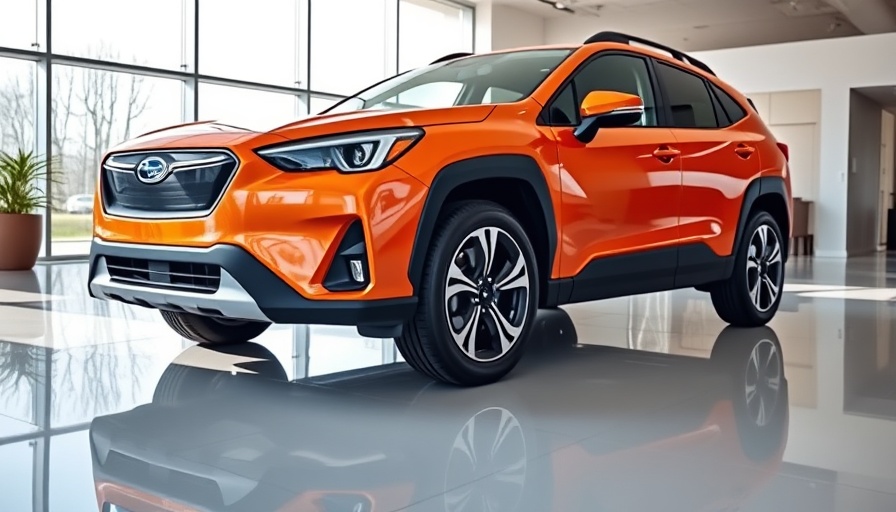
Subaru's Brave Shift from AWD to FWD: A Game Changer?
Subaru has long been synonymous with all-wheel drive and rugged, off-road capabilities. However, the release of the 2026 Subaru Uncharted marks a significant departure from tradition. As Subaru’s first significant foray into front-wheel drive in decades, the Uncharted represents a bold step in the evolving landscape of electric vehicles (EVs). Many automotive enthusiasts are left wondering if this shift could redefine the market for not only Subaru but also for what consumers expect from utility vehicles in an increasingly electrified future.
Electric Innovation: Riding the Toyota Wave
The Uncharted utilizes a platform shared with the new Toyota C-HR, raising questions about identity and innovation in the automotive sector. While badge engineering often leads to criticism of lack of originality, Subaru has assured that the Uncharted is far from just a Toyota in disguise. Unique styling elements and specific tuning set the Uncharted apart, presenting a familiar brand flavor while catering to urban practicality.
Performance Boost: Balancing Power and Efficiency
With its 221-horsepower front-wheel-drive variant, the Uncharted integrates efficiency with performance. Projected to travel over 300 miles on a charge thanks to its 74.4-kWh battery pack, it offers an everyday vehicle solution designed for the urban lifestyle. Meanwhile, the all-wheel-drive configurations, boasting a robust 338 horsepower, cater to those desiring both speed and all-weather traction. This ERV's agility positions it as a noteworthy competitor within Subaru’s lineup, particularly as it delivers a 0-60 mph time of just 5 seconds.
Comparative Industry Insights: Where Subaru Stands
As the automotive industry continues to evolve, it's worth examining Subaru’s positioning in the broader context of global trends. In 2023, the largest automobile manufacturers were spearheaded by industry giants like Toyota and Volkswagen, commanding innovative environmental strategies and building consumer trust. In this competitive field, how can Subaru leverage its unique identity while assimilating new technologies? The Uncharted may serve as a litmus test for Subaru’s adaptability and its competitive edge against both traditional combustion vehicles and emerging EV rivals.
Consumer Appeal: Expectations for Utility and Space
Despite being shorter than the Solterra, the Uncharted surprises with impressive cargo space, boasting 25 cubic feet behind the second row. Such versatility makes it a strong contender for families and city dwellers alike, who see value in how practical features can blend with modern technology. This aspect of the Uncharted emphasizes Subaru's intent to capture a market segment that seeks not just performance but also utility.
Charging Infrastructure: Keeping Up with Competitors
The Uncharted’s choice of a Tesla-style NACS charging port signifies its alignment with modern standards of convenience. Despite not being a leader in fast-charging capabilities, Subaru's offering still reflects the necessary benchmarks for today's EVs. In an industry where consumers are increasingly concerned about charging time, efficiency will play a pivotal role in how new models compete within their class.
What’s Next for Subaru: Industry Predictions
With the Uncharted set to launch in early 2026, many eyes are focused on how Subaru will further innovate or respond to market needs. Will the success of the Uncharted lead Subaru to explore more front-wheel-drive options in diverse markets, or could they revert to their all-wheel-drive roots? By carefully observing consumer feedback and adapting quickly, Subaru can not only redefine its brand identity but also shape the automotive industry’s trajectory as we enter a new era of electrification.
Embracing Electric Vehicles: The Road Ahead
As environmental concerns drive the automotive industry towards sustainability, the significance of electric vehicles cannot be overstated. The transition of traditional brands like Subaru towards more eco-friendly options represents a critical adaptation period. Navigating these changes thoughtfully can lead to new opportunities and a stronger bond with an evolving consumer base.
As we await pricing details and consider the upcoming 2026 Subaru Uncharted, it’s essential for consumers to keep abreast of market trends and potential incentives for new EV purchases. For those in the process of choosing their next vehicle, understanding the rapid shifts in the automotive landscape can empower more informed decisions.
 Add Row
Add Row  Add
Add 




Write A Comment